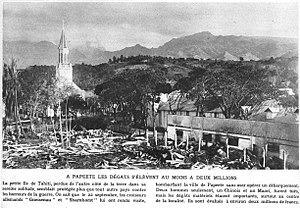Bombardment of Papeete
| Bombardment of Papeete | |||||||
|---|---|---|---|---|---|---|---|
| Part of Asian and Pacific theatre of World War I | |||||||
 Buildings in the city of Papeete destroyed by German shore bombardment. |
|||||||
|
|||||||
| Belligerents | |||||||
|
|
|
||||||
| Commanders and leaders | |||||||
|
|
|
||||||
| Strength | |||||||
|
Land: 160 infantry 2 shore batteries Sea: 1 gunboat 1 freighter |
2 armored cruisers | ||||||
| Casualties and losses | |||||||
| 1 gunboat sunk 1 freighter sunk Papeete severely damaged |
none | ||||||
|
Civilian casualties: 2 killed |
|||||||
German victory
The Bombardment of Papeete occurred in French Polynesia when German warships attacked on 22 September 1914, during World War I. The German armoured cruisers SMS Scharnhorst and Gneisenau entered the port of Papeete on the island of Tahiti and sank the French gunboat Zélée and freighter Walkure before bombarding the town's fortifications. French shore batteries and a gunboat resisted the German intrusion, but were greatly outgunned. The main German objective was to seize the coal piles stored on the island, but these were destroyed by the French at the start of the action.
The German vessels were largely undamaged but the French lost their gunboat. Several of Papeete's buildings were destroyed and the town's economy was severely disrupted. The main strategic consequence of the engagement was the disclosure of the cruisers' positions to the British Admiralty, which led to the Battle of Coronel where the entire German East Asia Squadron defeated a Royal Navy squadron. The depletion of Scharnhorst's and Gneisenau's ammunition at Papeete also contributed to their subsequent destruction at the Battle of the Falklands.
Word of war reached Admiral Maximilian von Spee—of the German East Asia Squadron—while at Ponape (17 July – 6 August). He concentrated the majority of his squadron at Pagan Island in the nearby Mariana Islands, and then steamed off into the Pacific with the Scharnhorst-class armored cruisers SMS Scharnhorst and Gneisenau, the Königsberg-class light cruiser SMS Nürnberg, the auxiliary cruiser SMS Titania, and several colliers at his disposal. Nürnberg and Titania were sent to gather intelligence at Hawaii and raid the cable station at Fanning Island. Von Spee then learned that Australian and New Zealand forces had captured German Samoa, and he sailed off in his flagship Scharnhorst—along with her sister ship Gneisenau—to engage what Allied forces they could find there. Failing to catch the Samoa Expeditionary Force at Apia and having seen no action at all since leaving Pagan Island, the men of Admiral von Spee's armored cruisers were eager to meet the enemy in battle.
...
Wikipedia
